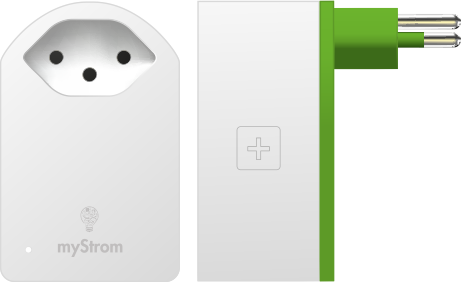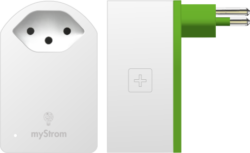
One annoying aspect of the internet of things conversation is that it is very Silicon Valley centric, and so revolves around devices I don’t really need (smoke detectors), problems I don’t have (multi-storey houses) and the wrong technical infrastructure (110 Volts / 60㎐ vs 230 Volts / 50㎐). Many systems also require one to buy everything from the same provider, something I don’t want to do.
I recently discovered MyStrom, a company that sells one single, simple product: a WLAN enabled power switch. This device is a swiss power plug which does two things: turn itself on or off, and measure the current it lets through. The devices have a documented API and consume around 1 Watt, they also have a manual switch, so in case of problem they can be controlled as regular electric switches. I was curious so I bought two of them.
The devices were clearly designed for Switzerland, their shape is triangular to fit in the triple power plugs in the wall. The plug has two buttons, a power control button and a WPS + button. A two colour LED shows the state of the plug. You can configure the plug either via WPS or using an interesting method: light pulses flashed from the screen of your mobile phone into a tiny receptor on the face of the power-plug. I used the latter method and it worked fine (you really need to put the screen against the power plug).
Once the switches are connected to the network you can either attach them to your Swisscom router (if you have one), or the MyStrom account. I chose the latter. The online tools lets you attach various configuration information (name, room) to the switches, define the price of you power consumption (important in Switzerland, as there are many local power utilities), you can also define some basic power management policies: turn off if consumption is below X Watts, turn off after some time on, alert if consumption is above Y Watts, etc.
Based on my previous checks on power consumption, 7 years ago, I assumed that one power drain would be the shelf with the kitchen appliances: micro-wave, bread-making machine. As often with assumptions, I was wrong: I had changed the bread making machine, the old one used 17 Watts in idle mode, now the whole shelf uses 1 Watt.
I used the other switch to measure the consumption of my desk: an old 17 inch screen, a thunderbolt dock and the power supply of the laptop. When the laptop sleeps and the display is in power saving mode, this setup still consumes 30 watts. When active consumption rises to 100 Watts.
I have to see where the switches would be most useful, the ability to automatically turn off various parts of the flat is certainly interesting.

J’en veux un ! voire deux !
Et il y a un mystrom.fr… mal traduit, avec plein de liens morts :-\ pointant vers un domadoo.fr qui ne semble pas les connaître.
Un des problèmes avec tous ces nouveaux gadgets est que les sociétés derrière semblent avoir une durée de vie à peine supérieure à celle du bout d’électronique moyen…
Oui, effectivement, c’est pour cela que c’était important pour moi d’avoir une API de contrôle, histoire de pouvoir continuer à les utiliser même si leur serveur meurt…
J’ai l’impression que la boîte est passée d’adapteurs powerline (ip sur 230V) avec des fonctions de gestion de courant à des prises qui ne font que la gestion de courant via wifi.